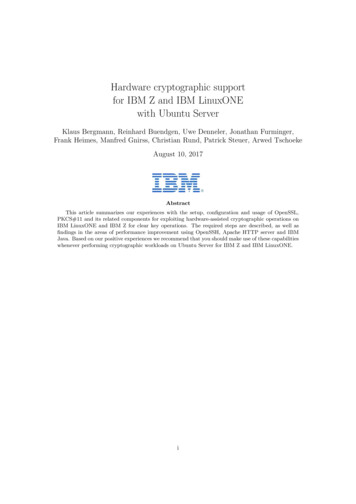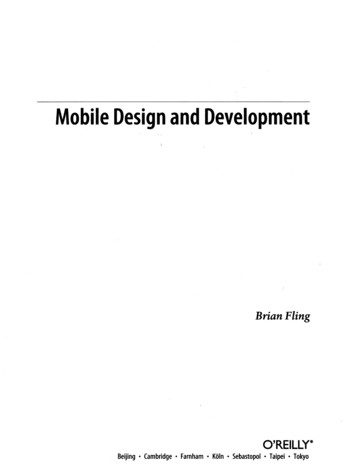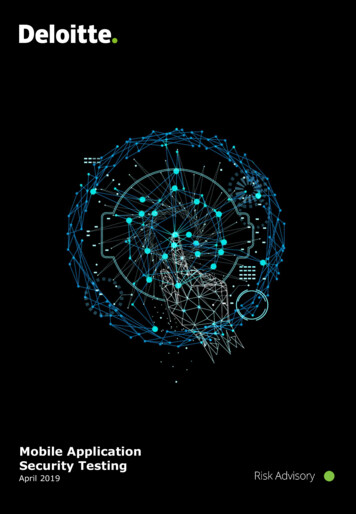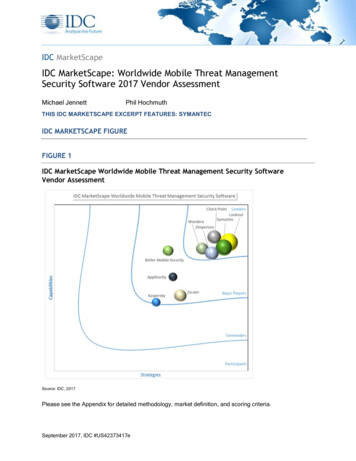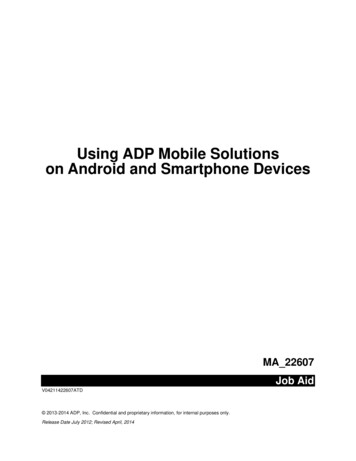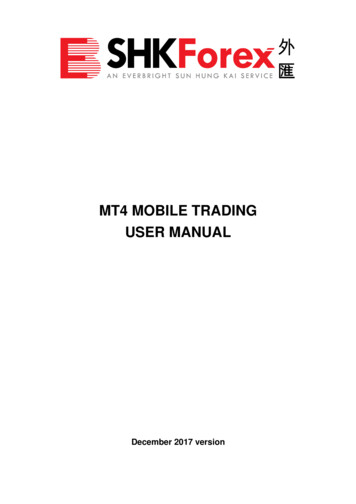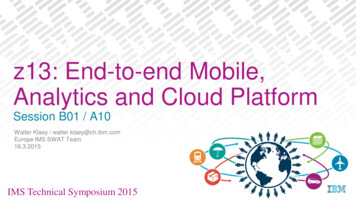
Transcription
z13: End-to-end Mobile,Analytics and Cloud PlatformSession B01 / A10Walter Klaey / walter.klaey@ch.ibm.comEurope IMS SWAT Team16.3.2015*IMS Technical Symposium 2015
TrademarksThe following are trademarks of the International Business Machines Corporation in the United States, other countries, or both.Not all common law marks used by IBM are listed on this page. Failure of a mark to appear does not mean that IBM does not use the mark nor does it mean that the product is notactively marketed or is not significant within its relevant market.Those trademarks followed by are registered trademarks of IBM in the United States; all others are trademarks or common law marks of IBM in the United States.For a more complete list of IBM Trademarks, see www.ibm.com/legal/copytrade.shtml:*BladeCenter , CICS , DataPower , DB2 , e business(logo) , ESCON, eServer, FICON , IBM , IBM (logo) , IMS, MVS, OS/390 ,POWER6 , POWER6 , POWER7 , Power Architecture , PowerVM , PureFlex, PureSystems, S/390 , ServerProven , Sysplex Timer ,System p , System p5, System x , z Systems , System z9 , System z10 , WebSphere , X-Architecture , z13 , z Systems , z9 ,z10, z/Architecture , z/OS , z/VM , z/VSE , zEnterprise , zSeries The following are trademarks or registered trademarks of other companies.Adobe, the Adobe logo, PostScript, and the PostScript logo are either registered trademarks or trademarks of Adobe Systems Incorporated in the United States, and/or other countries.Cell Broadband Engine is a trademark of Sony Computer Entertainment, Inc. in the United States, other countries, or both and is used under license therefrom.Java and all Java-based trademarks are trademarks of Sun Microsystems, Inc. in the United States, other countries, or both.Microsoft, Windows, Windows NT, and the Windows logo are trademarks of Microsoft Corporation in the United States, other countries, or both.Intel, Intel logo, Intel Inside, Intel Inside logo, Intel Centrino, Intel Centrino logo, Celeron, Intel Xeon, Intel SpeedStep, Itanium, and Pentium are trademarks or registered trademarks ofIntel Corporation or its subsidiaries in the United States and other countries.UNIX is a registered trademark of The Open Group in the United States and other countries.Linux is a registered trademark of Linus Torvalds in the United States, other countries, or both.ITIL is a registered trademark, and a registered community trademark of the Office of Government Commerce, and is registered in the U.S. Patent and Trademark Office.IT Infrastructure Library is a registered trademark of the Central Computer and Telecommunications Agency, which is now part of the Office of Government Commerce.* All other products may be trademarks or registered trademarks of their respective companies.Notes:Performance is in Internal Throughput Rate (ITR) ratio based on measurements and projections using standard IBM benchmarks in a controlled environment. The actual throughput that any user willexperience will vary depending upon considerations such as the amount of multiprogramming in the user's job stream, the I/O configuration, the storage configuration, and the workload processed.Therefore, no assurance can be given that an individual user will achieve throughput improvements equivalent to the performance ratios stated here.IBM hardware products are manufactured Sync new parts, or new and serviceable used parts. Regardless, our warranty terms apply.All customer examples cited or described in this presentation are presented as illustrations of the manner in which some customers have used IBM products and the results they may have achieved. Actualenvironmental costs and performance characteristics will vary depending on individual customer configurations and conditions.This publication was produced in the United States. IBM may not offer the products, services or features discussed in this document in other countries, and the information may be subject to change withoutnotice. Consult your local IBM business contact for information on the product or services available in your area.All statements regarding IBM's future direction and intent are subject to change or withdrawal without notice, and represent goals and objectives only.Information about non-IBM products is obtained Sync the manufacturers of those products or their published announcements. IBM has not tested those products and cannot confirm the performance,compatibility, or any other claims related to non-IBM products. Questions on the capabilities of non-IBM products should be addressed to the suppliers of those products.Prices subject to change without notice. Contact your IBM representative or Business Partner for the most current pricing in your geography.2
Innovation never stops. 2015 War of the walletsmobileUberpreneurfinancemobileHands-free carmobileanalyticsto dox, DoxinganalyticsautomobileGraph SearchanalyticsprivacyGorilla armprivacymobilecloud3retailhealthcare
Digital RevolutionWorld becoming smarterTransform interactionsPersonalized everythingIn the moment right nowWhat is happening?16 billion connected devices75 billion devices by 20207 billion smart phonesInfrastructure of the companyInfrastructure of the cityInfrastructure of the worldRespect and protect security and privacy4
5Explosion intransaction growthAnalytics ismoving to real timeHybrid cloud is thenew standarddriven by mobilityand the Internet ofThingsto capture newopportunities at thepoint of impactfor delivering service,agility, trust andefficiency
Introducing the IBM z13The mainframe optimized for the digital eraIBM z13 (z13)Machine Type: 2964Models:N30, N63, N96, NC9, NE110%Single thread capacityimprovement over zEC12Up to40%Total capacity improvementover zEC121Up to3X more available memory tohelp z/OS or Linux workloads10 TB2SODsUp to141 Performance, scale, intelligent I/O and securityenhancements to support transaction growth inthe mobile world More memory, new cache design, improved I/Obandwidth and compression help to serve upmore data for analytics Enterprise grade Linux solution, open standards,enhanced sharing and focus on businesscontinuity to support cloudzKVM * and GDPS virtualappliance for Linux on IBMzSystems * opens the door formore LinuxConfigurable cores – CP, zIIP,IFLs, ICFs, SAPUpgradeable from IBM zEnterprise 196(z196) andIBM zEnterprise EC12 (zEC12)1 Basedon preliminary internal measurements and projections. Official performance data will be available upon announce and can be obtained online at LSPR (Large SystemsPerformance Reference) website at: 060.nsf/pages/lsprindex?OpenDocument . Actual performance results may vary bycustomer based on individual workload, configuration and software levels* All statements regarding IBM's future direction and intent are subject to change or withdrawal without notice, and represent goals and objectives only.6
z13 – Designed for data andtransaction serving for themobile generation7Up to 36% fasterresponse time,61% betterthroughput and17% lower costper transactionthan distributedalternatives
Bridge systems of record to systems ofengagement for rapid service deliveryAnalytics run onSoR system foroptimalperformance andsecurityMobileFirstPlatform(on-prem)Mobile apps run either on-prem(using Linux on z Systems) or inthe cloud (via BlueMix )IMS MobileFirstPlatform(cloud)z/OSConnectWebSphere ASDB2 8AnalyticsCICS
z13 – Redesigned for the scale and speed of amobile generation141 cores and 40%* morecapacity in a single system2X* performance improvementwith crypto coprocessors formore secure transactions10 TB* memory plus 2Xincrease in cache size320 separate channelsdedicated just to driving I/Othroughput16 Gbps FICON links forfaster throughput* Compared to zEC129Performance, scale, intelligent I/O andsecurity enhancements to supporttransaction growth in the mobile worldz/OS Connect provides consolidated RESTAPIs for all z/OS transactionsSeamlessly channel z/OS transactions tomobile devices with MobileFirst PlatformApple iOS apps packaged with GBSimplementation services for z SystemsNew reference architectures enableintegration with back-end resources andend-to-end security from mobile device tomainframe
z13 – Designed for integratingtransactions and analyticsfor insight at the point of impact10Deliver insightsup to 17 Xfaster and with13 X betterprice /performancethan the closestcompetitor
Integrated analytics and transaction processingThe greatest value is achieved when analytics are runwhere the transactions and data originateInsights on everytransactionAnalytics as part ofthe flow of businessMore transactionthroughputAvoid (ETL) Eliminate complexity Eliminate cost Eliminate redundancy11Faster dataaccessIncreased analyticsperformanceDeliver real-time insights at the point of impact Improve customer experience Increase revenue opportunities Improve response time
z13 – Delivering insights at the point of impactIBM DB2 AnalyticsAccelerator acceleratesqueries for faster insightMega-memory and new opportunities for inmemory computingSIMD delivers acceleratedanalytics processing forcomplex querieszEDC reduces data transfer timeand storage cost by up to 75%16 Gbps FICON links reducelatency for workloads suchas DB2zIIPs help to lower the cost ofownership helping to helpconnect, manage, extend,and protect data12New machine architecture boosts complexmathematical model performanceUse Hadoop with IBM InfoSphere BigInsights to explore z Systems within thesecure zone of the mainframeIBM DB2 Analytics Accelerator and DB2BLU creating new and innovative use cases,such as in-database transformation andadvanced predictive analytics
z13 – Designed for efficient andtrusted cloud services totransform the economics of IT13Deliver superiorcloud servicesup to 32% lowercost than x86and 60% lowercost than publiccloud
z13 supports all dimensions of cloudservice deliveryPrivate Cloudz/OS and Linux on z Systems asthe foundation of the most secure,scalable private cloud infrastructure14Hybrid CloudPublic CloudLeveraging BlueMix andinteroperability with SoftLayerand other public cloud offeringsEnabling MSPs/CSPs to deliverdifferentiated mainframe-basedservice offerings
z13 – Redesigned for efficient and trustedcloud servicesUp to 8,000 virtual servers persystem, more than 50 per coreOpen virtualization with newKVM support (SOD)*z13 brings faster processing andhigher throughput of securetransactions (2X more throughputon crypto coprocessor)Business continuity and ITanalytics with enterprisegrade Linux solution15Open support extended with OpenStack ,PostgreSQL, Node.JS, and KVM (SOD)Enterprise-grade Linux provides thefoundation for public, private, and hybridcloudPatterns for Linux on z Systems to quicklybuild out complex cloud workload instancesImproved overall system performanceleads to a lower TCO compared to publiccloud deployments and deployments onx86 architecturesEnabling next generation cloudapplications with IBM Bluemix on zSystems* All statements regarding IBM's future direction and intent are subject to change or withdrawalwithout notice, and represent goals and objectives only.
Operating Systems focused on exploitinghardware innovation16z/OSVersion 2.1 z/VM Version 6.3 Improved price performance with simultaneous multithreadingtechnology – support for twice as many processors Improved systems management and economics Embracing Open Standards and Open Source Interoperability Supports more virtual servers than any other platform in asingle footprintz/VSE Version 5.1 Linux onz Systems Multithreading allows for per core software savings Ability to host and manage more workloads efficientlyand cost-effectively Automatic identification of unusual messages Integrated continuous availability & disaster recovery solutionImproved price performance for zIIP workloads with SMTSupport new analytics workloads with SIMD and large memoryDigitally sign audit records to reduce riskImproved operations agility with entitled z/OSMFReduced risk of access from unauthorized usersReduced memory constraintsWide portfolio using Linux on zContinued system usability enhancements with CICS ExplorerMore efficient communications
Reinventing enterprise IT for digital businessDesigned for data and transaction serving forthe mobile generationDesigned for integrating transactions andanalytics for insight at the point of impactDesigned for efficient and trustedcloud services to transform the economicsof ITThe trusted enterprise platform forintegrating Data, Transactions and Insight!ZSP04335-USEN-0017
z13 Technical detailsIMS Technical Symposium 2015
z13 Functions and Features (GA Driver Level 22)System, Processor, MemoryI/O Subsystem, Parallel Sysplex, STP, SecurtyFive hardware modelsNew PCIe Gen3 I/O fanouts with 16 GBps BusesEight core 22nm PU SCMLCSS increased from 4 to 6Up to 141 processors configurable asCPs, zIIPs, IFLs, ICFs, or optional SAPs4th Subchannel Set per LCSSz13Increased Uni processor capacityUp to 30 sub capacity CPs at capacitysettings 4, 5, or 6Increased (24k to 32k) I/O Devices (subchannels)per channel for all z13 FICON featuresFICON EnhancementsCPC Drawers and backplane OscillatorSR-IOV support for RoCESMT (for IFLs and zIIPs only) and SIMDNew Integrated Coupling Adapter (PCIe-O SR ) forcoupling linksEnhanced processor/cache design withbigger cache sizesSupport for up to 256 coupling CHPIDs per CPCUp to 10 TB of Redundant Array ofIndependent Memory (RAIM)CFCC Level 20CPC Drawer/Memory AffinityCrypto Express5S and Cryptographicenhancements with support for 85 DomainsLPARs increased from 60 to 85STP EnhancementsRAS, Other Infrastructure Enhancements19IBM zAware for Linux on z Systems (June 23, 2015)System Control Hub (SCH). Replaces BPHNew N 2 ‘radiator’ design for Air Cooled SystemRack Mounted Support Elements in the CPCKey Locks for doorsRack mounted HMCs for customer supplied rackSupport for ASHRAE Class A2 datacenterTKE 8.0 LICC
IBM z Systems naming for IBM z13 (z13)Brand Name: IBMProduct Class: IBM mainframeFamily Name: IBM z Systems Family Short Name: z SystemsProduct Line Name: IBM z Systems Product Line Short Name: z SystemsProduct Name: IBM z13 Short Name: z13Models: N30, N63, N96, NC9, NE1Machine Type: 2964Workload Optimizing Attachments:IBM z BladeCenter Extension (zBX) Model 004IBM DB2 Analytics Accelerator for z/OS Version 4Management Firmware: IBM z Unified Resource ManagerManagement Firmware Short Name: Unified Resource Manager or zManager20
IBM z Systems / LandscapeAn integrated, highly scalable computer system that allows many different pieces of work to be handled at the same time,sharing the same information as needed with protection, handling very large amounts of information for many users withsecurity, without users experiencing any failures in serviceWebSphereCoreCoreCICS DB2 IMS Java ApplTestDevelopmentJava ApplJVMDB2z/OSJVMz/OSNative LinuxWebSphereERPz/OSz/OSz/VMLinuxLinux forz Systemz/VMC JavaLinuxforz SystemDB2DB2LinuxForz SystemVirtual networking and switchingCP 1 CP 2CP nzIIPnIFL 1Large scale, robust consolidation platformBuilt-in Virtualization100’s to 1000’s of virtual servers on z/VMIntelligent and autonomic management of diverse workloads and system resources*zAAPs not available on z1321zAAPn*IFL n
z Systems - Processor Roadmapz131/2015zEC128/2012z1969/2010z102/2008Core 0Core 2MCIOsGXIOsL3BL3 0L3 0L2L2Leadership System Capacityand PerformanceL3 0 ControllerMCUCoPCoPGXL3 1 ControllerL2L2MCIOsGXIOsL3BCore 1L3 1L3 1Core 3Top Tier Single ThreadPerformance,System CapacityWorkload Consolidationand Integration Engine forCPU Intensive WorkloadsDecimal FPInfiniband64-CP ImageLarge PagesShared Memory22Leadership Single Thread,Enhanced ThroughputImproved out-of-orderModularity & ScalabilityDynamic SMTSupports two instruction threadsTransactional MemorySIMDAccelerator IntegrationDynamic OptimizationPCIe attached acceleratorsOut of Order Execution2 GB page supportBusiness Analytics OptimizedWater CoolingStep Function in SystemCapacityPCIe I/O FabricRAIMEnhanced EnergyManagement
z13 Technical detailsProcessor designIMS Technical Symposium 2015
Performance increase forever? Moore’s Law is a computing term which originated around 1970; the simplified version of this lawstates that processor speeds, or overall processing power for computers will double every twoyears. A quick check among technicians in different computer companies shows that the term isnot very popular but the rule is still accepted. Future challenges:– Density– Heat Gordon Moore stated in April 2005 that the law cannot be sustained indefinitely: "It can't continueforever. The nature of exponentials is that you push them out and eventually disaster happens."He also noted that transistors would eventually reach the limits of miniaturization at atomic levels.24
z13 Continues the CMOS Mainframe Heritage begun in 19945.5 GHz5.2 GHz600060005.0 GHz4.4 001.7 GHz1202*902*1.2 GHz 50%GHz 159%770 MHz 33%GHz 18% 26%GHz 6% 12%GHz-9%100010000 02000z900z900189 nm SOI16 Cores**Full 64-bitz/Architecture2003z990z990130 nm SOI32 Cores**SuperscalarModular SMP2005z9ecz9 EC90 nm SOI54 Cores**System levelscaling2008z10ecz10 EC2010z196z19665 nm SOI64 Cores**High-freq core3-level cache45 nm SOI80 Cores**OOO coreeDRAM cacheRAIM memoryzBX integration20122015zEC12zNextzEC12z1332 nm SOI22 nm SOIEC101 Cores**141Cores**OOO and eDRAMcacheimprovementsPCIe FlashArch extensionsfor scalingSMT &SIMDUp to 10TB ofMemory* MIPS Tables are NOT adequate for making comparisons of z Systems processors. Additional capacity planning required** Number of PU cores for customer use25
“The end of the GHz Race” x86 and POWER already transitioned to a throughput-centric model Frequency peaked for x86 in 2005, POWER in 2008 In System z we have held this off with unique cooling, packaging, technology, anddesign solutions2626
z System Servers Continue to Scale with z13168 engines141-way*z13Each new range continues to deliver:120 engines101-way*zEC12Maximum PCI New function Unprecedented capacity tomeet consolidation needs Improved efficiency tofurther reduceenergy consumption Continues to deliveringflexible and simplified ondemand capacity A mainframe that goesbeyond the traditionalparadigm96 engines80-way77 engines64-wayz19664 engines54-wayz10 ECz9 ECz99048 engines32-way20 engines16-wayz900Minimum PCIPCI - Processor Capacity Index*z/OS supports up to a 100-way only27z900z/OS 1.6z990z/OS 1.6z9 ECz/OS 1.6z10 ECz/OS 1.8z196zEC12z/OS 1.11 z/OS 1.13z13z/OS 2.1
IBM z13: Advanced system design optimized forSystem I/O Bandwidthdigital business832 GB/Sec*384 GB/Sec*288 GB/sec*172.8 GB/sec*Memory10 TB3TB1.5TB600512GB54-way64-way80-way* No server can fully exploit itsmaximum I/O bandwidth101-wayPCI – Processor CapacityIndex (IBM MIPS)28141-wayCustomer Processors90212021514PCI for1-way1695z13zEC12z196z10 ECz9 EC
z13 Radiator-based Air cooled – Front View(Model NC9 or NE1)Overhead PowerCables(option)2 x 1U SupportElementsPCIe I/O drawernumber 5InternalBatteries(optional)PowerSuppliesDisplays and keyboardsfor Support ElementsPCIe I/O drawersnumbers 1 to 4(Note: for anupgraded System,drawer slots 1 and2 are used for theI/O Drawer29System Control Hubs(used to be BPHs)PHYSICAL40312213LOGICALCPC Drawers, PCIeFanouts, Cooling watermanifold and pipes, PCIeI/O interconnect cables,FSPs and ethernet cablesNote: CPC Drawer pluggingnumbers are on the left andlogical numbers on the rightN 2Radiator PumpsOverhead I/O featureis a co-req foroverhead power option
z13 8-Core Processor Unit (PU) Chip Detail Up to eight active cores (PUs) per chip–5.0 GHz (v5.5 GHz zEC12)–L1 cache/ core 96 KB I-cache 128 KB D-cache 22nm SOI Technology Chip Area:– 17 layers of metal– 678.8 mm2– 3.99 Billion Transistors– 28.4 x 23.9 mm– 13.7 miles of copper wire– 17,773 powerpins– 1,603 signal I/Os30 –L2 cache/ core 2M 2M Byte eDRAM split private L2 cacheSingle Instruction/Multiple Data (SIMD)Single thread or 2-way simultaneous multithreading (SMT)operationImproved instruction execution bandwidth:–Greatly improved branch prediction and instruction fetch tosupport SMT–Instruction decode, dispatch, complete increased to 6instructions per cycle–Issue up to 10 instructions per cycle–Integer and floating point execution unitsOn chip 64 MB eDRAM L3 Cache–Shared by all coresI/O buses–One InfiniBand I/O bus–Two PCIe I/O busesMemory Controller (MCU)–Interface to controller on memory DIMMs–Supports RAIM design
z13 System Design Changes 22nm Processor with SIMD, SMT New Memory Controller Integrated I/O with PCIe DirectAttach Crypto Express5S Single Chip Modules Drawer-Based CPC Design Cable-Based SMP Fabric Oscillator Backplane Flexible Service Processor(FSP2) Integrated Sparing On-chip power/thermal monitor /control31 FICON Express16S 1U Support Element 2.7M lines of firmware changed Radiator Design improvements Expanded operating environment (RearDoors)
z13 PU and SC SCMassemblyCappedPUSC SCM withThermal Module2x SC SCMs(Air Cooled)6x PU SCMsPU Chip6x PU SCMsunder thecold-platesSC ChipNNDrawer 3NDrawer 2NDrawer 1Front of CPC Drawerfor Fanouts/FSPsDrawer 4NNNN324 CPC DrawerSystemconnectivityCappedSCFully assembled CPC Drawerwith the chilled watersupply manifold lifted to the left
Cache Latency Why needs the CPU access Memory? Instruction / Data Cache latency for z196 (1, 4, 12, 32 & 77 are relative access times)Ratios are still accurate33
Hiperdispatch Motivation to Hiperdispatch– In the past, System z hardware, firmware, and software have remained relatively independent of each other– CPU gets faster and faster, memory is still slow, connections “remains on light speed” CPUs have different distance-to-memory attributes– Memory accesses can take less than 10 to several hundred cycles depending upon cache level / local or remote repositoryaccessed– Reduce the multi-processor overhead Hardware cache can be optimized when a given unit of work is consistently dispatched on the same physical CPU (orrelated set of CPUs) With z/OS 1.8 and z10 IBM introduced Vertical processing instead of horizontal processing Interaction between z/OS and PR/SM to optimize work unit and logical processor placement to physical processorsconsists of 2 parts In z/OS (sometimes referred as Dispatcher Affinity)Because it attempts to create a temporary affinity between work and processors In PR/SM (sometimes referred as Vertical CPU Management)Because it attempts to assign physical processors exclusively to logical processors (as much as possible)34
z13 CPC Drawer Cache Hierarchy Detail2 SC SCM Chips(1 per node)Single CPC Drawer View (N30 Model) – 2 NodesNode 2Node 1SC SCM1L4 CacheNICL4 CacheNICL3 CacheL3 CacheL3 CacheL3 CacheL3 CacheL3 1PU8PU1PU8PU1PU8PU1PU8PU1PU8PU1PU8PU SCM2PU SCM3Node 1 - CachesL1 private 96k i, 128k dL2 private 2 MB i 2 MB dL3 shared 64 MB / chipL4 shared 480 MB / node- plus 224 MB NICPU SCM4 PU SCM56 PU SCM Chips(3 per node)L2PU1PU SCM1 SC SCM2MemoryMemoryPU SCM6Node 2 - CachesL1 private 96k i, 128k dL2 private 2 MB i 2 MB dL3 shared 64 MB / chipL4 shared 480 MB / node- plus 224 MB NIC* Up to 8 PU coresper chipSingle PU core* Not all PU’s active35
z13 Processor Unit Allocation/Usage – zIIP to CP 2:1 40-1621 z13 Models N30 to NC9 use drawers with 39 cores. The Model NE1 has 4drawers with 42 cores. The maximum number of logical ICFs or logical CPs supported in a CF logicalpartition is 16 The integrated firmware processor (IFP) is used for PCIe I/O support functions Concurrent Drawer Add is available to upgrade in steps from model N30 to modelNC9361. At least one CP, IFL, or ICFmust be purchased in everymachine2. Two zIIPs may be purchasedfor each CP purchased if PUsare available. This remainstrue for sub-capacity CPs andfor “banked” CPs.3. On an upgrade from z196 orzEC12, installed zAAPs areconverted to zIIPs by default.(Option: Convert to anotherengine type)4. “uIFL” stands for UnassignedIFL5. The IFP is conceptually anadditional, special purposeSAP
z13 Technical detailsProcessor: new functionsIMS Technical Symposium 2015
Simultaneous Multi-Threading (SMT) Simultaneous multithreading allows instructions from one or two threadsto execute on a zIIP or IFL processor core. SMT helps to address memory latency, resulting in an overall capacity*(throughput) improvement per core Capacity improvement is variable depending on workload. ForAVERAGE workloads the estimated capacity* of a z13:––––zIIP is 38% greater than a zEC12 zIIPIFL is 32% greater than a zEC12 IFLzIIP is 72% greater than a z196 zIIPIFL is 65% greater than a z196 IFL SMT exploitation: z/VM V6.3 PTFs for IFLs andz/OS V2.1 PTFs in an LPAR for zIIPs8050 SMT can be turned on or off on an LPAR by LPAR basis by operatingsystem parameters. z/OS can also do this dynamically with operatorcommands. Notes:1. SMT is designed to deliver better overall capacity (throughput) formany workloads. Thread performance (instruction execution rate foran individual thread) may be faster running in single thread mode.2. Because SMT is not available for CPs, LSPR ratings do not includeit38*Capacity and performance ratios are based on measurements and projections using standardIBM benchmarks in a controlled environment. Actual throughput that any user will experiencewill vary depending upon considerations such as the amount of multiprogramming in the user'sjob stream, the I/O configuration, the storage configuration, and the workload .Which approach is designed forthe highest volume** of traffic?Which road is faster?**Two lanes at 50 carry 25% more volume iftraffic density per lane is equal
Increasing Data and Compute RequirementsSIMD, Large Memory and SMT Enable Upper Right Quadrant ionLargeMatrixMathString,Integerz13 WorkloadsCompute IntensityPredictiveIT CryptoNext Best ActionAdvancedAnalyticsWhat will ressTraditional ssBig SortSmall StringOperationsBig ScanData Intensity39
SIMD (Single Instruction Multiple Data) processingIncreased parallelism to enable analytics processing Smaller amount of code helps improve executionefficiency Process elements in parallel enabling more iterations Supports analytics, compression, cryptography,video/imaging processing Enable new applications Offload CPU Simplify codingScalarSIMDSINGLE INSTRUCTION, SINGLEDATASINGLE INSTRUCTION, MULTIPLE DATAA2A1C3B3A3B2B1C2C1Sum and StoreInstruction is performed forevery data element40ValueINSTRUCTIONA3B3A2B2A1B1C3C2C1Sum and StorePerform instructions onevery element at once
SIMD (Single Instruction Multiple Data) AcceleratorData-level parallelism / operate on multiple data elements simultaneouslyScalar coderead the next instructionget this numberget that numberadd themput the result hereread the next instructionget this numberget that numberadd themput the result hereread the next instructionget this numberget that numberadd themput the result here.read the next instructionget this numberget that numberadd themput the result thereSIMD codeand decode itand decode itInstr. Decoderead instruction and decodeitget these 4 numbersget those 4 numbersadd themput the results hereNumber 1and decode it Instr. DecodeSingle InstructionNumber 2 Number 1a Number 1b Number 1c Number 1dResult 1and decode it Multiple DataRepeat4 times Result 1Result 2Result 3Result 4(Significantly) smaller amount of code improved execution efficiency Number of elements processed in parallel (size of SIMD / size of element)41 Number 2a Number 2b Number 2c Number 2dDoOnce
SIMD Roadmap and Client Value- ILOG-CPLEX- Faster mathematical modeling solutions- XMLSS- Improved performance for parsing- Exploiters: COBOL, PL/I, DB2 Pure XML- MASS/ATLAS w/SIMD- Construct rich complex analytics models- Port from POWER and x86 to acceleratebusiness insight- Increased programmer productivity- XL C/C - Improved price/perf, single-threadperformance- Java.Next- Improved String and Floating Pointperformance- Auto-SIMD- COBOL V5.2- Improved price/perf, single-threadperformance- Reduced execution time- Improved efficiency02/2015zNext GA1 (SIMD-enabled Instruction Set andRegister files), z/OS V2.1 SPE- ILOG-CPLEX V12.6.1 or V12.6.0.2, XMLSS- MASS/ATLAS (z/OS: zEC12, zNext GA1)- MASS/ATLAS (zLinux: zEC12, NO SIMD)- Java.Next, XL C/C for z/OS, COBOL V5.2,PL/IHLASMISV: z/XDC (Colesoft)42z/VMRoadmap is subject toChange- MASS/ATLASw/SIMD- Improved price& singlethreadperformance- Reducedexecution time- XL C/C - Auto-SIMDLinux RHEL7.2 /SLES12.1- MASS/ATLASw/SIMD- XL C/C , GCC &LLVM Compilers;binutils, gdb, andregister filesave/restorez/OSUnder Investigation- z/VM- Security- R- Java Enabled Workloads: WAS/Liberty, DB2, IMS,CICS, ODM, Traditional WAS, SPSS, Cognos,InfoSphere Streams, Unica SPSS Analyzer- Timeline varies as new JVM gets adopted- XL C/C - Auto-SIMD:recognize codefragments thatcan be SIMDenabled3Q2015LinuxLast Updated:08/03/2014SIMD HW and SW Stack willgrow in ease of use and capability09/2015z/OS V2.2- XLC/C SIMD EcosystemSIMD Optimized WorkloadsEnabling LibrariesEnabling Compilers / Built-in Functions20162017
Compilers in the Spotlight on IBM z13Enterprise COBOL 5.2 on z13 vs. Enterprise COBOL 5.1 on zEC12 Up to 14%
Walter Klaey / walter.klaey@ch.ibm.com Europe IMS SWAT Team 16.3.2015 z13: End-to-end Mobile, Analytics and Cloud Platform Sessio
